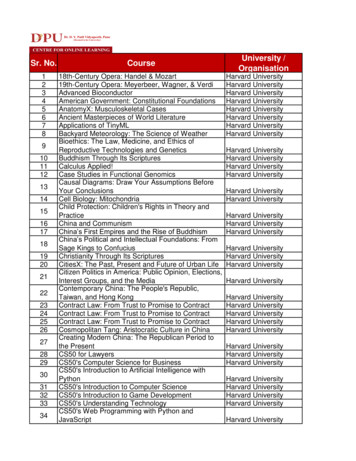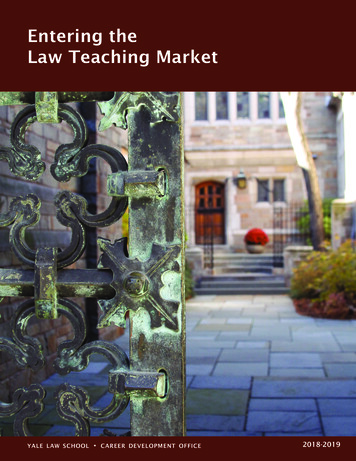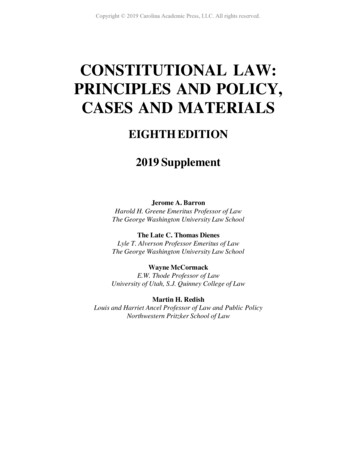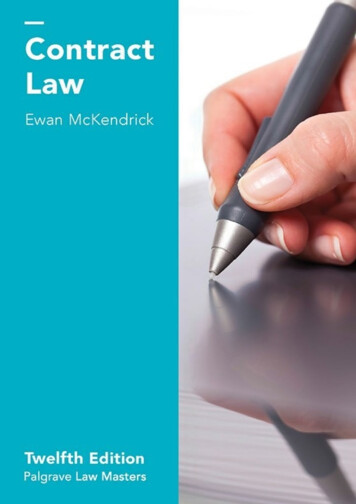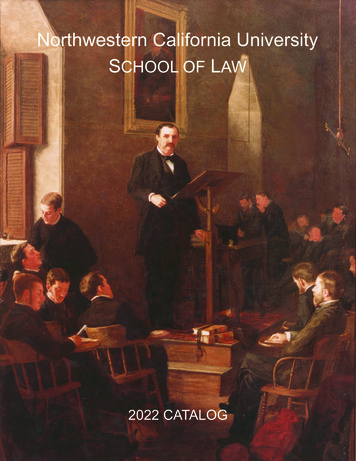
Transcription
Columbia University School of Law435 West 116th StreetNew York, NY 10027Phone: 212.854.2670 Fax: 212.854.1108 Email: admissions@law.columbia.eduWebsite: www.law.columbia.eduTHE BASICSColumbia University School of Law was formallyestablished in 1858, approximately 65 years afterColumbia College began offering law classes to suchstudents as Alexander Hamilton, author of The FederalistPapers, and John Jay, the first Chief Justice of the UnitedStates Supreme Court. The school was accredited by theABA in 1923 and is one of the oldest law schools in theUnited States.The school is located in the Morningside Heightsneighborhood of New York City (about 20 minutes fromdowntown Manhattan), on the edge of the Columbiacampus. Although the cost of attendance is considerable(approximately 70,000 a year), the school doesguarantee affordable University housing to students forall three years, something which definitely helps keepliving costs down.Columbia Law has a large enrollment of around 1,300students, and significant academic and extracurricularofferings: 8 clinics, 3 externships, multiple study abroadprograms in 11 countries, 14 scholarly journals, andover 70 student organizations. It has produced someimpressive alumni throughout the years: Both FDR andTeddy Roosevelt attended Columbia Law (althoughneither graduated), and nine U.S. Supreme CourtJustices also call it their legal alma mater.With an Ivy League pedigree and a name recognized andrespected all over the world, Columbia is undoubtedly amember of the law school elite.Columbia University School of LawApplication deadline: 11/15 (Early); 2/15 (Regular)Application fee: 80Financial aid deadline: 3/1Type of school: PrivateTuition and fees: 50,428 (2010 - 2011)Admissions: Rolling (decisions by late April)Acceptance percentage: 15%Incoming class size: 400Early Action/Early Decision available: Yes, bindingPart-time program available: NoGPA AND STANDARDIZED TESTSLSAT 25th - 75th percentile range: 170 - 175GPA 25th - 75th percentile range: 3.60 - 3.81TOEFL required for some LL.M. applicants only.APPLICATION REQUIREMENTSLetters of recommendation: 2 requiredRequired essays: Personal statementOptional essays: Diversity essay encouragedDean’s Certification: Required for matriculating studentsAdditional documentation: Résumé (required; 2-pagemaximum)1
Columbia Law: The PowerScore PerspectiveA highly portable degreeViewpoints galoreWhen it comes to name recognition, Columbia is rightup there with the most well-known law schools (think:Harvard). It is also arguably the most prestigious lawschool in New York City (with NYU a very close second).These two aspects allow Columbia graduates to apply forjobs outside the Northeast without having to resort tolengthy explanations about where they went to school.The Columbia name tends to speak for itself, and will openjust about any door you can think of.No surprise here: A school of this caliber located in a cityof this magnitude will attract just about every ethnicity,and every political and religious viewpoint imaginable.Combine that with Columbia Law’s commitment to bothminority and foreign student enrollment, and the schoolbecomes a microcosm of the larger NYC melting pot.Urban is as urban doesRed-tape bluesA large student body, combined with what students claimis a slow-moving, bureaucratic administration, can makethings like obtaining housing and signing up for classesa pain. Be prepared to ask for things multiple times, andexpect some delays after each of your requests.Even though the school’s location in New York City isconsidered one of its best attributes, there’s no arguingthat Columbia Law’s address is about as urban as top NYClaw schools can get. When you combine the “concreteHoly tuition, Batman!jungle” feel with the rather considerable incoming classThe cost of attending Columbia Law is prohibitive. Clockingsize (380 students), it is easy to seein at close to 50,000 a year for tuitionwhy some students might feel lost atalone (and with planned yearly hikesthis school. Columbia does a good jobon the way), your degree comes withColumbia grads canof creating a welcoming environmenta hefty price tag. And don’t forgetfor its students, but that doesn’tapply for jobs anywhere about the cost of living in New Yorknegate the fact that a large classCity. The Big Apple can definitely putin the world withoutwithin a large law school within aa strain on anyone’s pocketbook,large city can be a detractor for some.particularly a law student living inhaving to resort toself-imposed poverty.A theoretical bendWhile Columbia does have aconsiderable clinical program, theseclinics are probably the only placewhere students will have a chanceto approach the law from a practicalperspective. For the most part, classesand faculty are mostly concerned withpresenting the theoretical side of thelaw.lengthy explanationsabout where they wentto school.The Columbia nametends to speak foritself, and will openjust about any dooryou can think of.Unparalleled facultyAt Columbia you will find one of themost distinguished and accomplished law faculties in theworld. It would be impossible to list all the combinedaccomplishments of the Columbia Law faculty, due to boththe sheer number of achievements and the size of thefaculty itself. The student-to-faculty ratio is exceptional,and students speak highly of both the quality andaccomplishments of their professors.Affordable NYC housing?!Columbia Law guarantees cheap housing for all threeyears of law school for its students. If you can get throughthe hassle of dealing with the Columbia Housing Office,you won’t find a better deal in the city. If you decide togo outside the Columbia Housing safety net, though, beprepared to shell out considerable cash for a student pad.2Where’s the curb appeal?The school’s location is less than ideal.Although it is located in Manhattan(admittedly a plus), its placement atthe edge of the Columbia Universitycampus on Morningside Heights canlend a dreary feel to the building,particularly on drab, rainy days orcold winter mornings. There area number of other New York Citylaw schools that are preferable toColumbia when it comes to locationand curb appeal.Where’s the curve appeal?Students report that the bulk of the student body hoversaround the 3.0-3.25 mark. Hard work will get you a B/B .An A is scarce, as is a C. This might be a boon to thosewho just want to work hard and don’t want to worryabout grades, but will likely be frustrating for those usedto getting As for their sweat-soaked academic labors.Gentlemen, start your enginesThe academic environment is competitive and can certainlyfeel a bit cut-throat at times. And understandably so in theNew York City legal market, where competition for jobs,internships, externships, and public interest positions canbe fierce, regardless of the collegiality of the school.The PowerScore Guide to the Top U.S. Law Schools
Columbia Law: The NumbersACCEPTANCE RATESFull-time: 15% (1,235 of 8,505 admitted)Part-time: N/AGPA AND LSAT SCORESGPA - 75th percentile: 3.81GPA - Median: 3.72GPA - 25th percentile: 3.60LSAT - 75th percentile: 175LSAT - Median: 172LSAT - 25th percentile: 170ENROLLMENT AND ETHNICITYAfrican-American: 30 (M); 75 (F); 8.0% of student bodyAmerican Indian: 1 (M); 1 (F); 0.2% of student bodyAsian-American: 87 (M); 111 (F); 15.1% of student bodyCaucasian: 442 (M); 334 (F); 59.2% of student bodyHispanic: 8 (M); 7 (F); 1.1% of student bodyMexican-American: 19 (M); 18 (F); 2.8% of student bodyPuerto Rican: 8 (M); 11 (F); 1.5% of student bodyInternational: 59 (M); 57 (F); 8.9% of student bodyNon-Reported: 21 (M); 21 (F); 3.2% of student bodyTRANSFERS (FIRST-YEAR) AND ATTRITIONTransfers in: 79Transfers out: 71L attrition: 1 (0 Academic, 1 Other)2L attrition: 6 (0 Academic, 1 Other)3L attrition: NoneFINANCIAL AIDMerit aid available? Yes*Grants and scholarships available? YesStudents receiving grants: 691, 54.5% of student bodyMedian grant amount: 10,250.00LRAP program available? YesCAREER SERVICESOn-campus Career Services Office? YesNumber of full-time career services staffers? 12Career services specializations: Law firms, government,public interest, public service, pro bonoOn-Campus Interview (OCI) program? Yes; OCI happensin the fall for 2Ls and 3Ls, and in the spring for 1Ls.EMPLOYMENT STATISTICS**All statistics are 9 months after graduationEmployment status known: 408, 100.00% of classEmployment status unknown: 0, 0.0% of classEmployed: 405, 99.3% of classPursuing graduate degrees: 1, 0.2% of classUnemployed: 2, 0.5% of classTYPE OF EMPLOYMENTAcademia: 4, 1.0% of classBusiness and Industry: 8, 2.0% of classGovernment: 7, 1.7% of classJudicial Clerkship: 44, 10.9% of classLaw Firms: 331, 81.7% of classPublic Interest: 12, 3.0% of classGEOGRAPHIC LOCATIONNew York, in particular New York City, is a huge market ofemployment for Columbia Law grads, followed the rest ofthe states in the Northeast U.S.Students employed in-state: 66.2%Students employed in foreign countries: 3.5%Number of states where students are employed: 23The biggest market for Columbia Law grads is the Northeast(69% of graduates), followed by the West/Rocky Mountainregion (11.2%), the Mid-Atlantic (9.7%), and the Southeast(5.2%).ALUMNI NETWORK*Columbia Law’s Office of Financial Aid only considersstudents based on their financial need; however, anumber of “stated purpose” merit-based fellowships areavailable for students of Brazilian, New Zealand, or Indianbackground.LIBRARY RESOURCESColumbia Law has a strong network of alumni workingacross the United States and in many foreign countries,and also has alumni groups and associations set up in everyregion of the globe, aimed at helping alumni network andexpand their career prospects.BAR PASSAGE RATESWireless network availability? YesNumber of wired connections available: 3,028Hours per week the library is open: 102Study seating capacity inside the library: 369Number of full-time professional librarians: 19Columbia University School of LawFirst-time takers: 355 (92.96% reporting)Average school pass rate: 96.67%Average state pass rate: 88.98%Average pass rate difference: 7.69%3
Columbia Law: The School“I could have chosen a less intense school, but I would havegiven up a lot of valuable opportunities doing so,” saysMarti M. ‘11. Intense seems to be the word of choice formany of Columbia Law’s current students and grads. “Theopportunities are endless; it would have been impossibleto have taken advantage of them all,” adds a recent grad.Incoming class size: 400 (2009)Typical first-year section size: 95CURRICULUMColumbia Law calls its first-year class load the FoundationCurriculum. The Foundation Curriculum includes thestandard 1L classes seen at other schools (Civil Procedure,Contracts, Torts, Constitutional Law, Criminal Law, andProperty), as well as the opportunity to take one electiveduring the Spring Semester.In addition to the basic 1L classes and elective, first-yearstudents are required to take Legal Methods (whichserves to “inaugurate generations of Columbians tolegal research, analysis, and writing in a manner at onceintellectually rigorous and professionally supportive,” andis completed prior to matriculation in all other first-yearcourses), and Legal Practice Workshop (providing “trainingin the analysis of legal problems and in the hands-on use ofa variety of legal materials”). (Source: Course descriptions)First-year students are also required to participate in theFoundation Year Moot Court, which requires the draftingof a brief and the arguing of a case.FACULTYStudent-to-faculty ratio: 10.1 : 1Some of the school’s notable faculty include:Jane Ginsburg, daughter of U.S. Supreme Court JusticeRuth Bader Ginsburg and author of trademark andcopyright casebooks.Tim Wu, known in technology circles for popularizing thephrase and concept of “net neutrality.”Patricia Williams, author and race and gender law expert.Louis Henkin, a pioneer in the field of comparativeconstitutionalism.ACADEMIC OPPORTUNITIESCLINICS AND EXTERNSHIPS: The clinical program atColumbia Law is open to all second- and third-yearstudents. The school currently has eight clinical programsavailable: Child Advocacy, Environmental Law, HumanRights, Prisoners and Families, Lawyering In The DigitalAge, Mediation, Nonprofit Organizations/Small Business,and Sexuality and Gender Law. Through Columbia Law’sSocial Justice Program, students can also participate in anumber of externships (consisting of a substantial seminarand field experience at a non-profit organization orgovernment agency). Current externship offerings includeopportunities with the United Nations, the National StateAttorneys General Program, and Volunteer Lawyers for theArts.STUDY ABROAD: Columbia Law has semester-abroadprograms in Argentina, China, France, Germany, Hungary,Israel, Italy, Japan, The Netherlands, South Africa, andSwitzerland.JOINT DEGREE: The school has a number of internationalJD/LLM, JD/LLB, and JD/MA programs as well as dualdegree MBA, PhD, MPH, MS, MA, MSW, and MFA programswith other Columbia University schools and departments.JOURNALS AND PUBLICATIONSColumbia Law has 14 student-run journals: ColumbiaBusiness Law Review, Columbia Human Rights Law Review,Columbia Journal of Asian Law, Columbia Journal ofEnvironmental Law, Columbia Journal of European Law,Columbia Journal of Gender and Law, Columbia Journal ofRace & Law, Columbia Journal of Tax Law, Columbia Journalof Law & Social Problems, Columbia Journal of Law & theArts, Columbia Journal of Transnational Law, Columbia LawReview, Columbia Science and Technology Law Review, andThe American Review of International Arbitration.MOCK TRIAL AND MOOT COURTColumbia Law has extensive intramural mock trial andmoot court programs. The school also participates andis consistently successful in numerous national andinternational moot court and mock trial competitions. NOTABLE ALUMNI Given Columbia Law’s age and prestige, the number of notable alumni it claims is not surprising. U.S. PresidentsTheodore Roosevelt and Franklin Delano Roosevelt both attended Columbia Law (although they both, interestingly,dropped out before completing their studies, and neither ever obtained an official J.D. degree). Ulysses S. Grant, Jr.,son of U.S. President General Ulysses S. Grant also attended Columbia Law (and did graduate). Eric Holder (class of1976), the current Attorney General of the United States, is also an alum, as are nine current and former SupremeCourt Justices. The list of influential politicians (both U.S. and international) that have attended the school is enormous.Columbia Law also claims many successful alums in the arts, athletics, religious, activism, and private arenas.4The PowerScore Guide to the Top U.S. Law Schools
Columbia Law: The StudentsOne current Columbia Law student describes her classmatesas “very interesting, intelligent, and involved.” “I loved,loved, loved my classmates,” enthused a recent grad.The environment at the school, emphasizes onemember of the class of ‘11, is “intense, but not overlycompetitive.” “Columbia does an extraordinary jobcatering to a diverse student body. They really make aneffort to make people feel welcome,” states Jeff T. ‘08.,and other students agree: the school works hard to makeeach class a cohesive whole by providing numerousactivities for classmates to get to know one another.A quick look at the sheer number of activities andextracurriculars available showcases a student bodythat is varied and engaged, and interested in exploringas many opportunities as possible. There was only onenegative aspect of the school environment mentioned byour student evaluators: “The social scene is a bit weak forolder students.” However, with New York City just outsidethe door, older students looking to supplement their lawschool activities with adult extracurriculars will likelyhave an easy time finding activities that fit their needs.Diversity is also something Columbia Law prides itselfin. With a 2009 total minority enrollment of 28.7%,and 8.9% of the student body hailing from a foreignnation, Columbia is one of the most diverse law schoolsin the country. This is definitely one of the studentbody’s strongest assets, and adds to the value, depth,and breadth of classroom discussions and debates.Columbia Law’s student body is also enriched by the LL.M.(Master of Laws) candidates that make up part of eachincoming class. These students, according to the ColumbiaLaw website, “have held important positions in theircountries’ governments, corporations, or in political orhuman rights organizations,” and consistently add anotherlayer of individuality to the law school conversation.ACTIVITIES AND ORGANIZATIONS African Law Students Association Alpine Society American Civil Liberties Union American Constitution society Amnesty International Asian and Pacific American LawStudents Association Black Law Students Association California Society Christian Legal Society Civil Rights Law Society Columbia Card Club Columbia Business and LawAssociation Columbia Gastronomy Society Columbia International AntitrustLaw Association Columbia International ArbitrationAssociation (CIAA) Columbia Latin American BusinessLaw Association Columbia Law Opera and ClassicalSociety Columbia Law Revue Columbia Law School Democrats Columbia Law School MilitaryAssociation (CLSMA) Columbia Law School Republicans Columbia Law School Softball Club Columbia Law School Trial Team Columbia Law Women’sAssociation Columbia Real Estate Law Society Columbia Society of InternationalLaw Columbia Strategic SimulationSociety Criminal Justice Action Network Deans’ Cup De Vinimus Domestic Violence Project Education Law and Policy Safety Empowering Women of Color Entertainment, Arts, and SportsLaw Society Environmental Law Society Federalist Society Golf Club Harlem Tutorial Program High School Law Institute Impact Insite J. Reuben Clark Law Society Jewish Law Students Association Koleinu Korean Law Students Association(KLSA) Latino/a Law Students Association Law Students for ReproductiveJustice Law Students for Social Enterprise(LSSE) Mentoring Youth through LegalEducation (MYLE) Middle Eastern Law StudentsAssociation (MELSA) Midwest Society Moot Court National Lawyers Guild Native American Law StudentsAssociation New England Law StudentsAssociation NHK: Japanese Legal StudiesAssociation Outlaws Public Interest Law Foundation Rightslink Running from the Law Society for Chinese Law Society for Immigrant and RefugeeRights Society for Law, Science andTechnology South Asian Law StudentsAssociation Student Animal Legal DefenseFund Student Hurricane Network Student Senate Tenants’ Right Project Transfer and Visiting StudentOrganization Unemployment Action Center Y’allSA Yoga Club CLASS PROFILE 8,505 students applied for entry toColumbia Law class of 2011, with 397eventually matriculating.The incoming class hailed from 38U.S. states, the District of Columbia,Puerto Rico, the Virgin Islands, and21 foreign countries.52% of the class was female, 48%was male, 37% were minorities orstudents of color, and 10% wereforeign.78% of the class was between theages of 21 and 24, 21% was 24 orolder, and 1% was 20 or younger.37% of the class came to law schooldirectly after college.The most popular majors in theincoming class were Political Scienceand Government (25%), Economics(14%), History (12%), and Literature/English (10%). The least popularwere Psychology (3%) and Finance/Accounting/Business (1%).11 members of the class had M.A.degrees, 8 had M.S. degrees, and 4Columbia University School of Lawhad Ph.Ds. Another six had otherforms of advanced degrees.The class was varied in accolades andexperiences, and included engineers,entrepreneurs, financial analysts,management consultants, FulbrightScholars, economists, human andcivil rights activists, journalists andeditors, military veterans, nationaland Olympic athletes, Peace Corpsvolunteers,performingartistsand musicians, political aides andanalysts, teachers and professors,and valedictorians and salutatorians.5
Columbia Law: The CitySetting: UrbanPARKING AND PUBLIC TRANSPORTATIONColumbia Law is located in the Manhattan borough of NewYork City, near the New York/New Jersey state line. Nestledjust a few blocks away from the Hudson River and sitting atthe edge of the Columbia University campus, it is centrallypositioned to allow for the full urban feel of New York City,complete with roaring traffic and plentiful subway stops.LIVING EXPENSES“I enjoy being in NYC for the myriad opportunities,” says acurrent student, “but it is certainly expensive.” The cost ofliving in one of the world’s most expensive metropolises isclearly one of the drawbacks to attending Columbia Law(or any of the New York City law schools). A student canexpect to pay at least 66,000 a year in tuition and livingexpenses while attending Columbia Law.Estimated academic year living llaneousTOTAL 11,550.00 4,950.00 3,700.00 20,200.00HOUSINGColumbia Law has housing available for its students, andguarantees some type of University housing for all threeyears of Law School for all admitted first-year law studentswho apply for housing by May 1 of the year they expect tomatriculate. Compared to standard New York City housingrates, Columbia housing is extremely reasonable.Y 979- 2,913*Rates are for Columbia-provided housingDEMOGRAPHICSThe U.S. Census Bureau estimates the 2006 population ofNew York City to be 8,214,426 people, with 57.3% of thepopulation between 18 and 65 years of age. 27.4% of thepopulation has a bachelor’s degree or higher.Population density in the New York City area (as per the2000 census) is 26,403 persons per square mile.The 2000 census puts the ethnic makeup of the city as44.7% white, 27.0% of Hispanic or Latino origin, 26.6%African American, 9.8% Asian, 0.5% American Indian orAlaskan native, 0.1% native Hawaiian or Pacific Islander,and 4.9% from two or more races.6As is the case with most New York City schools, the studentmantra when it comes to transportation is “Don’t bring acar!” Parking is both difficult to find and extremely costly,and maintenance costs are hard to justify considering howinfrequently you will use your vehicle.AREA ATTRACTIONS & ENTERTAINMENT*Values provided by Columbia Law. Travel expenses not includedOn-campus housing available?Apartment rental range (1 BR/1 BA)*There are few places in the world with a publictransportation system that is as well-developed as thatof New York City. The city’s subway system runs almost24 hours a day, and Grand Central Terminal, also knownas Grand Central Station, is one of the biggest railwaystations in the world. Although students may find thetransportation system a little intimidating and confusingat first, most quickly adapt to the fast-paced subway, taxi,and pedestrian life, and can get from one place to anotherwithin the city with ease.It’s New York City: “[The] opportunities are endless,” saysa current student. From the rich cultural heritage of nearbyHarlem (the famous Apollo Theater is only a few blocksfrom the law school) to the bright lights of Broadway (justa subway ride away), the opportunities for out-of-schoolentertainment really are “too numerous to list,” says arecent graduate.The Columbia Law viewbook puts it best: “New York Cityoffers unparalleled opportunities for personal growth,enrichment, and just plain fun. This is a city of mindboggling scope and variety, where 80 languages are spokenand where an Italian deli, an Ethiopian restaurant, and aChinese noodle shop share the same block. It is a city withhundreds of museums, art galleries, and theaters.“Music lovers can choose from major venues such asLincoln Center to small clubs in Greenwich Village toimprovisational jazz in Central Park.“For sports enthusiasts, whether athletes or fans, the cityprovides an exciting array of opportunities for exercise,competition, and enjoyment.”There is also plenty to do right in Morningside Heights: Takein a free musical performance at the Manhattan School ofMusic (or head down the street to Julliard and attend ashow there). Visit the General Grant National Memorialwhere 18th U.S. President Ulysses S. Grant is entombed.Go to Straus Park and see the memorial for the victims ofthe Titanic. Visit one of the many historic area churches.Or eat at any of the uniquely New York restaurants just afew blocks’ walk from the school’s front door.The PowerScore Guide to the Top U.S. Law Schools
member of the law school elite. Columbia University School of Law 435 West 116th Street New York, NY 10027 Phone: 212.854.2670 Fax: 212.854.1108 Email: admissions@law.columbia.edu Website: www.law.columbia.edu THE BASICS Application deadline: 11/15 (Early); 2/15 (Regular) Application fee: 80 Financial aid deadline: 3/1 Type of school .

